Spot on images taken with my pocket camera.
Jan 22, 2016 11:48:44 #
jim quist wrote:
if its on the same place with every photo you take then its on the sensor.
It goes out of focus with change in focal length, so it is not on the sensor, but on one of the moving glass elements. You would have to disassemble the lens and clean it. Easier to gen another pocket camera.
Jan 22, 2016 11:59:33 #
I am not familiar with this camera, but if it is not of an interchangeable lens type, then we have the question of how the dust smidge get inside in the first place. Since a digital sensor is an ekectronic device, might this be a case of dead and dying pixels. A pixel is just a cluster of electric charge storage sites and why could they not 'short' out. Need a fancy term for the last two words.
Jan 22, 2016 12:11:28 #
John_F wrote:
I am not familiar with this camera, but if it is not of an interchangeable lens type, then we have the question of how the dust smidge get inside in the first place. Since a digital sensor is an ekectronic device, might this be a case of dead and dying pixels. A pixel is just a cluster of electric charge storage sites and why could they not 'short' out. Need a fancy term for the last two words.
If it were dead pixels, the size and focus of the spot would not change with focal length.
Jan 22, 2016 13:21:06 #
amfoto1
Loc: San Jose, Calif. USA
Doesn't look like dead pixels to me. Usually those fail in one color channel or another, causing a spot of color the opposite channel... or a plain white speck if the entire pixel dies.
It could be dust... or it might be fungus. It's definitely something inside... either on the sensor, inside the lens or on the lens' rear element. (Size and clarity of the spot can change depending upon both aperture and zoom focal length.)
Since that camera has a fixed, non-interchangeable lens, it will require significant disassembly to find out what it is and try to clean it. This will mean some labor costs at a repair shop (varies, depending upon the shop), but may or may not require any parts.
It's hard to imagine how dust could get inside that type camera... but it can and does manage to do so. Most aren't really fully sealed.
Fungus is possibly more likely, because moisture that fosters it's growth can all-too-easily be from condensation forming on the surfaces inside a camera under various conditions, especially if using it in extreme temperature variations.
If it's fungus, it can cause permanent damage. Sometimes fungus etches the surface it's grown on. The sooner the better, dealing with fungus. It also can spread to other gear left nearby an infected item.
It could be dust... or it might be fungus. It's definitely something inside... either on the sensor, inside the lens or on the lens' rear element. (Size and clarity of the spot can change depending upon both aperture and zoom focal length.)
Since that camera has a fixed, non-interchangeable lens, it will require significant disassembly to find out what it is and try to clean it. This will mean some labor costs at a repair shop (varies, depending upon the shop), but may or may not require any parts.
It's hard to imagine how dust could get inside that type camera... but it can and does manage to do so. Most aren't really fully sealed.
Fungus is possibly more likely, because moisture that fosters it's growth can all-too-easily be from condensation forming on the surfaces inside a camera under various conditions, especially if using it in extreme temperature variations.
If it's fungus, it can cause permanent damage. Sometimes fungus etches the surface it's grown on. The sooner the better, dealing with fungus. It also can spread to other gear left nearby an infected item.
Jan 22, 2016 13:27:55 #
Personally the cause is irrelevant!
the cost of the repair is not,
does the OP repair, replace or live with it, that is the question, and only he can answer, we each eill have our own view, in my case I decided I could not live with it. Traded it and replaced with a newer model, Bob.
the cost of the repair is not,
does the OP repair, replace or live with it, that is the question, and only he can answer, we each eill have our own view, in my case I decided I could not live with it. Traded it and replaced with a newer model, Bob.
Jan 22, 2016 13:50:24 #
wdross
Loc: Castle Rock, Colorado
tmehrkam wrote:
I am seeing a spot on the images produced by my Ca... (show quote)
This say something is internally on one of the lense elements and will not clean up by cleaning the front element. If it is on the intenal rear element, the fix may be somewhat easy. If it is internal to the lense itself, personally I would buy a new camera before taking the actual lense apart. Realigning the elements will not be fun or even easy.
Jan 22, 2016 14:35:36 #
amfoto1 wrote:
Doesn't look like dead pixels to me. Usually those... (show quote)
This fungus suggestion is a real feasible possibility. A bit of fungus grows from a tiny, tiny bit if fungus, which could have entered the camera during manufacture. That the camera body might not be 'sealed' it might very well be tight enough to block that bit of fungus. But to an oxygen molecule or a water molecule the most perfect camera seal would look like a 12-lane expressway, so the fungus grow fuel could easily get in. OP might try contacting the manufacturer about the manufacturing history of the camera. Further, if oxygen and water can get inside, why could they not do a 'number' on the sensor?
Jan 22, 2016 16:01:24 #
I've had this in two compacts in my time, a Ricoh, then a Samsung. There is dirt on one of the rear elements of the lens. Not economic to repair, but I fixed my Ricoh by hitting it!
If otherwise all is lost, take out the battery and SD card, then try bashing the base of the camera as hard as you dare onto the heel of your hand. If not fixed, put an old leather glove or similar on a block of wood, and hit the base of the camera onto that as hard as you dare. It worked for my Ricoh. The Samsung was a warranty repair.
If otherwise all is lost, take out the battery and SD card, then try bashing the base of the camera as hard as you dare onto the heel of your hand. If not fixed, put an old leather glove or similar on a block of wood, and hit the base of the camera onto that as hard as you dare. It worked for my Ricoh. The Samsung was a warranty repair.
Jan 22, 2016 16:06:00 #
I would have to disagree with the dust on the sensor theories and agree with dust on one of the elements. If it were on the sensor and it covered say 4 pixels then those same 4 pixels would be covered whether the aperture or zoom changed. Now the edge may be more or less defined depending on aperture but the size would remain constant and definitely not to the extent that is shown in the 2 test shots. If the dust was on one of the elements that would change the size and focus depending on where that point of dust was in relation to the sensor plane. That said, I would have to agree with Bob. If it bothers the OP then get a new camera, if not then lets get out and do some more shooting. :-D
Jan 22, 2016 16:08:41 #
tmehrkam wrote:
I am seeing a spot on the images produced by my Ca... (show quote)
You say you 'I cannot see any spot on the lens' but yet you make no mention of any cleaning attempts.
Here's my WAG for your problem - there'a tiny 'spec' on the front element, probably a dried water drop.
My suggested cure is to clean the lens using photo-quality lens tissue & photo-quality lens cleaning liquid.
Jan 22, 2016 16:14:46 #
I have a couple of things to try.
Vacuum cleaner over the lens. Some else had luck with this.
Banging has been already been tried.
Taking the camera apart and seeing if I can get to the sensor and rear element of the lens without destroying alignment. This is the most likely to work but no guarantee. It makes sense to me that the obstruction is on the rear element. Maybe the sensor.
I like taking things apart. If I was to retire it I would take it apart anyway just to look at things. I have always been that way. You would be surprised how often you can fix things. I even have a clean room available at work which will increase the likely hood of getting the dust out without introducing more dust.
I made one good camera out of two broken Samsung cameras. My daughter purchased one. Dropped it in a week and tweaked the lens. Then she dropped the replacement a couple of months later and broke the display. A source of parts and a screw driver yielded a working camera which was broken within six months.
Don't ask about the iPhones. :-{
The rear lens and sensor is tiny. It does not take much to cause problems.
If all else failed then I will upgrade. I would like to have a manual mode. I might look at paying slightly more if I can find a camera that can still live in my pocket.
Until then I have my G2 and DSLR> Neither of which can fit in my pocket.
Vacuum cleaner over the lens. Some else had luck with this.
Banging has been already been tried.
Taking the camera apart and seeing if I can get to the sensor and rear element of the lens without destroying alignment. This is the most likely to work but no guarantee. It makes sense to me that the obstruction is on the rear element. Maybe the sensor.
I like taking things apart. If I was to retire it I would take it apart anyway just to look at things. I have always been that way. You would be surprised how often you can fix things. I even have a clean room available at work which will increase the likely hood of getting the dust out without introducing more dust.
I made one good camera out of two broken Samsung cameras. My daughter purchased one. Dropped it in a week and tweaked the lens. Then she dropped the replacement a couple of months later and broke the display. A source of parts and a screw driver yielded a working camera which was broken within six months.
Don't ask about the iPhones. :-{
The rear lens and sensor is tiny. It does not take much to cause problems.
If all else failed then I will upgrade. I would like to have a manual mode. I might look at paying slightly more if I can find a camera that can still live in my pocket.
Until then I have my G2 and DSLR> Neither of which can fit in my pocket.
Jan 22, 2016 17:18:24 #
tmehrkam wrote:
I have a couple of things to try. br br Vacuum cl... (show quote)
A man after my own heart! I love dismantling stuff when it's no longer fit for purpose, and have opened several compacts including Fuji and Canon. I'm pretty sure that the lenses will be held together in a unit which will sit over a board which holds the sensor. You may be able to separate the lens unit from the sensor bit and use a blower to shift the dirt. Unfortunately, you're quite likely to introduce more dirt, no matter how careful you're being. If the speck is inside the lens unit, you're most unlikely to get it all reassembled with all the lenses concentric.
Good luck!
Jan 23, 2016 04:58:28 #
Jan 23, 2016 12:52:59 #
I did a little exploratory disassembly. What I found is a little discouraging.
See Front View with cover off, rear view with covers off.
The front view shows the camera electronics on the left. The front of the lens assembly and the flash control pc board in the right. There is a back up battery for setup and the real time clock on the lower right.
In the peek under the display you see the PC board covering the sensor. They obviously do want you to get in. There is glue around the edge and security screws like used on I phones. The glue is a bit of the problem but I have screw drivers to fit the special screws.
There is a flex ckt over the back attaching to the front of the lens. A lot more disassembly will be required for proceeding any further.
What stopped me is the charged flash capacitor. It will have to be discharged before proceeding a little further. Feels lake about 300 volts left on the charge.
Could use a screw driver to discharge the cap but there is a risk of damaging the electronics. I will need to make a tool to do it safely.
See the photo of the capacitor. And another of the pc board that houses the zoom switch, shutter switch and mode switch. The actuators are on the case and the plastic piece draped over the camera.
No wasted space in this camera.
I put the camera back together. It works just like before spot and all.
See Front View with cover off, rear view with covers off.
The front view shows the camera electronics on the left. The front of the lens assembly and the flash control pc board in the right. There is a back up battery for setup and the real time clock on the lower right.
In the peek under the display you see the PC board covering the sensor. They obviously do want you to get in. There is glue around the edge and security screws like used on I phones. The glue is a bit of the problem but I have screw drivers to fit the special screws.
There is a flex ckt over the back attaching to the front of the lens. A lot more disassembly will be required for proceeding any further.
What stopped me is the charged flash capacitor. It will have to be discharged before proceeding a little further. Feels lake about 300 volts left on the charge.
Could use a screw driver to discharge the cap but there is a risk of damaging the electronics. I will need to make a tool to do it safely.
See the photo of the capacitor. And another of the pc board that houses the zoom switch, shutter switch and mode switch. The actuators are on the case and the plastic piece draped over the camera.
No wasted space in this camera.
I put the camera back together. It works just like before spot and all.
Front view with covers off
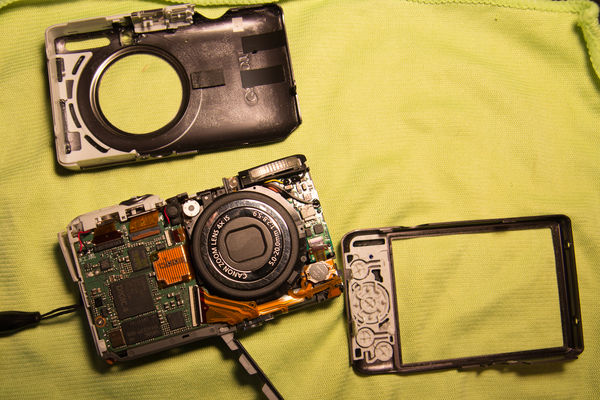
Rear view with the covers off.
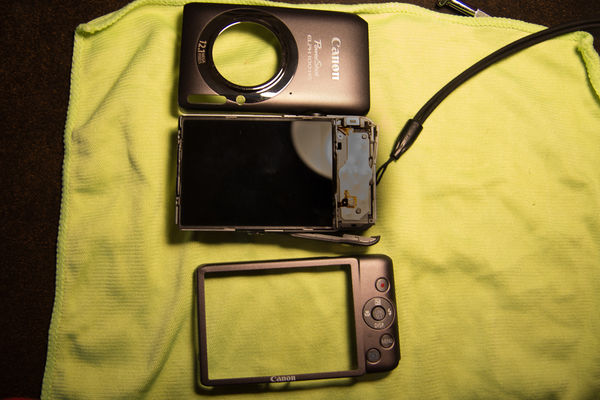
A peek under the display
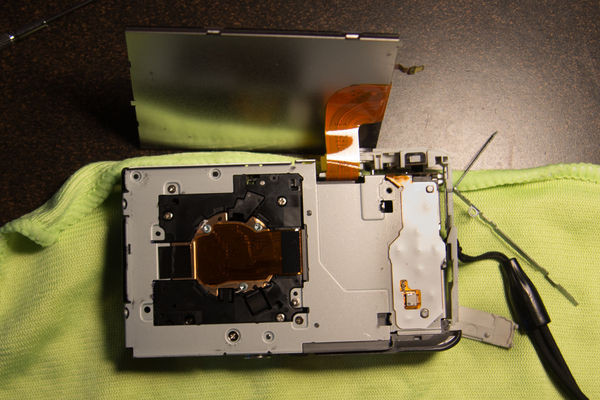
The flash capacitor
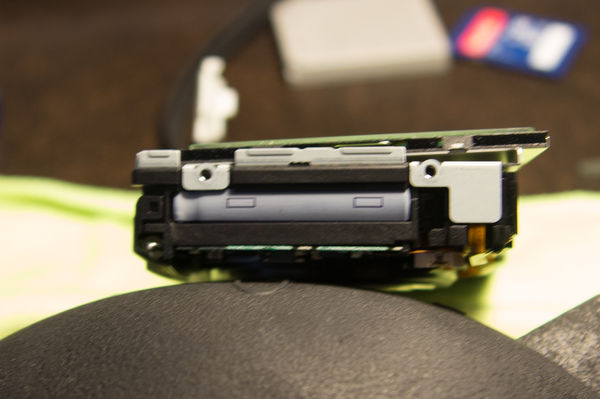
Shutter and zoom swithes
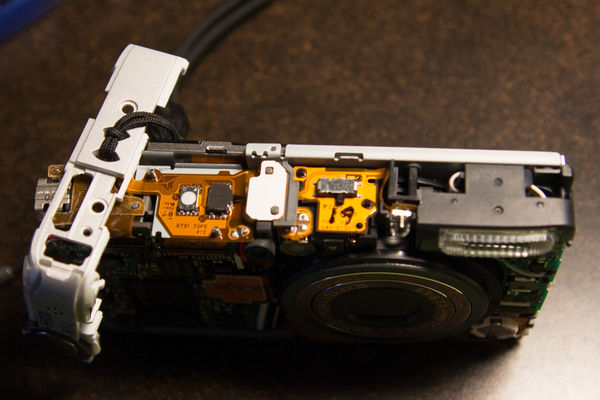
Jan 23, 2016 13:10:04 #
bobmcculloch wrote:
Had a spot like that appear on my G7, now I have a G15, cost to clean was more than the cost to replace, KEH bought the G7 from me.
Funny - but sad.
If you want to reply, then register here. Registration is free and your account is created instantly, so you can post right away.






